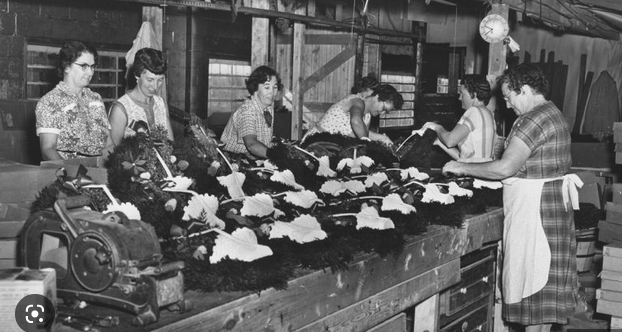Milton was the holly capital; smallpox almost ruined Christmas
For most of five decades starting in the early 1900s, Sussex County was the leading exporter of Christmas holly wreaths, made by hand by county residents and farmers.
Holly central was the area in and around Milton. By the 1930s, Milton became known as “The Land of Holly.”
The rise of the industry can be attributed to Charles G. Jones Sr. of Milton, a fertilizer salesman, who started his wreath-making business in 1906 and became the state’s most successful exporter. Known as “Jones, The Holly Wreath Man,” his creative marketing and quality products resulted in the sale of local goods throughout the United States and foreign countries.
Following Charles’ death in 1944, his son, William T. Jones, took over the business. In 1951, he created an 11-foot-diameter wreath – thought to be the world’s largest ever – to decorate the front of Radio City Music Hall in New York City.
On May 1, 1939, Delaware’s General Assembly officially designated the American holly as Delaware’s state tree.
When holly was jolly
Roots of the holly industry date back to the late 1890s, when farmer William Buell started shipping crates of holly branches to major cities on the East Coast and as far away as Chicago.
Within a few years, residents looking to supplement their income started making holly wreaths for the Christmas season. In 1900, nearly 5,000 crates of wreaths were shipped out from the area.
The idea caught on in other areas of Sussex County. And why not? Holly was super abundant, and large department stores were clamoring for the beautiful wreaths.
By 1936, during the Great Depression, some 2 million wreaths were shipped out of Sussex County.
According to Delaware Department of Agriculture records, it’s estimated that in 1938, the Delaware holly industry brought in as much as $1 million to the local economy.
A family could earn as much as $500 during the holiday season by making and selling wreaths.
But all good things seem to come to an end. The advent of plastic wreaths in the late 1940s, combined with a scarcity of holly, led to the demise of the industry in the late 1950s. In addition, a federally mandated minimum farm wage of $1 per hour also drove up costs for those hiring people to make wreaths.
However, memories of The Land of Holly are kept alive each Christmas season with Milton's Holly Festival. And wreath-making classes are numerous during the season.
Smallpox during the holiday
A real Grinch invaded Sussex County in 1919 and nearly ruined the Christmas season. In the fall, 20 cases of suspected smallpox were detected in the Millsboro-Oak Orchard area. At that time, smallpox was serious business, and state health officials stepped in to keep the disease contained.
The state banned all shipments of wreaths and greens from Sussex County, police kept people out of infected areas and quarantines were in place.
Vaccinations were also mandated, and by Dec. 11, every person in the Indian River Hundred had to receive a vaccination or face arrest. People were ordered to carry vaccination cards in public places.
Sound familiar?
Millsboro seemed to be the hot spot for the outbreak.
As more cases were detected, the vaccine mandate spread to every person in the Lewes and Rehoboth, Broadkill, Georgetown, Dagsboro and Baltimore hundreds. A deadline of Dec. 27 was in place for everyone to get vaccinated. Newspaper reports said the compliance rate was 75%.
In January 1920, a health inspector doing checks on compliance in the area found 10 shop merchants who did not have vaccination cards. However, police and town officials refused to help him serve arrest warrants.
As the official relaxed at the Brick Hotel in Georgetown, an angry crowd started to assemble, filling the hotel lobby and The Circle demanding that he leave. People protested against the mandatory vaccination requirement.
Sound familiar?
Although accounts of the “mob” that descended on The Circle vary widely, there is historic proof that at least some people showed up and that the health official was escorted out of town.
The smallpox scare was over by the end of February.
Thanks to Jim Duffy, author of “Secrets of the Eastern Shore,” for some of this information.






















































